This expert tutorial is all you need to make the best stuffed grape leaves or dolmas! These flavor-packed grape leaves are stuffed with a tantalizing mixture of rice; meat; and loads of fresh herbs and warm spices, then cooked in a bright lemony broth. I learned how to make stuffed grape leaves in my mother’s Mediterranean kitchen many years ago, and I’m sharing all her expert tips and tricks with step-by-step photos to show you. Vegetarian option included.
Stuffed grape leaves, also known as dolmas or dolmades, are arguably the most iconic Mediterranean food out there.
Homemade dolmas are one of my personal favorites, they will always remind me of my mother’s Mediterranean kitchen. I first learned to make them as a young teen in my mother’s Egyptian kitchen. It’s the sort of food that’s more fun to make in groups. So, the ladies of the family would gather around our small kitchen table, stuffing and rolling grape leaves, while catching up on life. Great memories!
If you’ve tried dolams at your local Greek or Mediterranean restaurant, you’re in for a treat! I’m about to show you step-by-step how to make the BEST stuffed grape leaves in your own kitchen for a fraction of the price. And you might want to grab a few friends to help you with this fun activity.
What are Dolmas: Stuffed Grape Leaves?
The word Dolma, from the Turkish verb Dolmak, basically means “to be filled,” referring to all sorts of stuffed foods from grape leaves to stuffed tomatoes, zucchini, or even bell peppers.
Now, you’ll find many variations of stuffed grape leaves recipes, from Turkey and Greece to Lebanon, and Egypt where it’s called Warak Enab (Grape Vine Paper.) Some recipes containing meat, others vegetarian. Some containing tomato sauce, others cooked in a lemony broth. I have yet to meet a stuffed grape leave, dolma, or Greek dolmades that I didn’t love, but this recipe is my absolute favorite.
What’s in stuffed grape leaves? In this recipe, grape leaves are stuffed with a tasty meat and rice mixture, seasoned with warm spices (allspice and cumin) and loaded with fresh herbs in the form of parsley, dill and mint. Then, once stuffed, the grape leaves are cooked in a tasty lemony broth.
I love to serve these dolmades with a side of Greek tztatziki sauce and Greek salad or tabouli for a light meal. But I have lots more ideas for you below, so keep reading on!
How to Make Stuffed Grape Leaves (Dolmas)
Step 1: Prepare the Grape Leaves
We’re using jarred grape leaves in brine, no cooking needed. But before using in this recipe, remove them from the jar and rinse well. Let them drain in a colander while you prepare the stuffing.
Step 2: Prepare the Stuffing
The stuffing here is made of rice, cooked ground beef, and a few chopped fresh herbs (parsley, dill, and mint).
First, rinse the rice and soak in water for 20 minutes (this is an important step, read on for more tips.) Then drain well. And while the rice is soaking cook the meat. Sautee finely chopped onions, add the meat and cook until fully browned. Be sure to drain any excess fat, then season the meat with kosher salt and pepper, allspice and cumin (so tasty!) Let cool.
Combine the meat, rice, and fresh herbs. Add a generous drizzle of extra virgin olive oil (I used Private Reserve Greek EVOO) and toss to combine. Add pinch of kosher salt.
Step 3: Stuff and Roll Grape Leaves
I like to start by preparing my cooking pot so that I can arrange the grape leaves as I stuff them.
Lightly oil the pot with some extra virgin olive oil, then add a few layers of grape leaves and top with sliced tomatoes. This protects the stuffed grape leaves touching the bottom of the pot from scorching.
To stuff grape leaves, work one leaf at a time. Lay the leaf flat on a cutting board with the more textured side facing you. Cut off the stem.
Take a heaping teaspoon of the rice stuffing mixture (a little bit less than 1 tablespoon) and place in the center of the leaf (close to where stem was).
Fold the sides over the filling and roll, keep tucking the left and right sides as you roll (think of this like you’re rolling spring rolls or cigars.)
Fold and roll grape leaves tightly enough but not too tight so the rice has room to expand as it cooks.
Step 4: Assemble Grape Leaves in Cooking Pot
Neatly arrange the grape leaves in rows, seam-side down, in your prepared pot, covering the circumference of the pot.
Then place a small plate inverted on top (this helps keep them in place while cooking.) Boil the water or broth and pour over the grape leaves, arriving at the top layer and somewhat covering (about 4 cups liquid, maybe a little more.)
Step 5: Cook Grape Leaves on Stovetop
Cover the pot with its lid and cook over medium heat for 30 minutes until the liquid has been absorbed. Uncover and remove the plate, then pour juice of 2 lemons. Cover again with the lid (no need for the plate at this point), cook on low heat for 30 to 45 more minutes or until fully cooked.
Let rest for 20 to 30 minutes, uncovered, before transferring to serving platter.
Tips for Making this Grape Leaves Recipe
I’ve been making grape leaves with my mom since my young teen years, she taught me a few important tips for making grape leaves. Here they are:
1. Soak The Rice in Water Before Using in the Stuffing. Two important ingredients of our grape leaves stuffing here are cooked ground beef and rice. It’s important to rinse the rice well to get rid of excess starch which causes rice to be sticky. Then soak the rice for 20 minutes or until you can break one grain of rice by pressing it between your index finger and your thumb. This way, your rice cooks evenly as the interior of the grain actually cooks before the exterior looses its shape. (I do the same when I cook my Lebanese rice and Greek lemon rice, works every time!)
2. Do NOT Over Stuff the Grape Leaves! Don’t over-stuff the grape leaves, remember that the filling is mostly of rice and it will expand as it cooks.
3. Roll tightly BUT allow for room for expansion. Roll the grape leaves tightly enough, so that they don’t unravel or become undone while cooking, but again remember rice will expand as it cooks so don’t fold too tightly or the rice won’t cook properly.
4. Keep the Grape Leaves from Floating or Unraveling While Cooking. To do this, make sure the grape leaves are assembled in your pot with the seam-side down. Then, add a small inverted plate on top of the assembled grape leaves in the pot to help keep them intact and prevent them from floating while cooking. Once the liquid has been absorbed, you can remove the plate to finish cooking as instructed.
5. Let Cooked Grape Leaves Rest for 30 Minutes before Serving. I know, it’s so hard not to immediately dig into those tasty grape leaves! But for best results, allow them to rest for 20 to 30 minutes so that any remaining liquids are absorbed and the leaves set nicely, plus they just taste better.
Vegetarian Grape Leaves Option
Since I published this post, I’ve received a number of requests asking for a vegetarian grape leaves recipe. I plan to put out a full tutorial on that, but here is essentially what you need to make this recipe vegetarian:
- The difference in vegetarian grape leaves is obviously in the stuffing mixture. You will need to omit the meat and add 1/2 cup more rice.
- Sautee the onions (no meat this time) until translucent. And add onions to the rice. Add spices (allspice and cumin) and pinch of salt and add the fresh herbs. Mix to combine and use this vegetarian mixture in the recipe as outlined.
Where to Find Grape Leaves?
Many grocery stores now carry jarred grape leaves in brine; check the international food section. I typically use the Orlando Brand grape leaves, and you can buy it here on Amazon(affiliate link.)
Can I use Fresh Grape Leaves to make Dolmas?
If you’re lucky enough to find fresh grape vine leaves, by all means, you should use them to make these dolmas. To use them in this recipe, first be sure to wash them well, then blanch them in boiling hot water. Remove from water using a slotted spoon and place them in a colander to fully cool and drain. From there, you can use them as indicated in the recipe. And if you have any extra, try using them to wrap Greek meatloaf!
What to Serve with Stuffed Grape Leaves
People often ask me if they should serve dolmas or stuffed grape leaves cold or hot. And what to serve with stuffed grape leaves?
Traditionally, Greek dolmas, particularly the meatless kind, are served at room temperature or slightly cooler as part of Mezze! That’s never a bad idea, and don’t forget some Tztaziki, creamy hummus, or some smoky Baba Ganoush to serve along.
But, since these are stuffed grape leaves with meat, you can absolutely serve them warm as the main course with a side of Tzatziki (or plain yogurt) and Greek salad or tabouli! You can also serve them as a next to Zucchini Fritters (Kolokithokeftedes); Greek lamb; grilled lamb chops; roast chicken; or Souvlaki!
Watch the video for how to make them:
SHOP OUR ONLINE SHOP FOR QUALITY OLIVE OILS, ALL-NATURAL SPICES AND MORE!
Print
Stuffed Grape Leaves (Dolmas)
- Total Time: 1 hour 45 minutes
- Yield: Up to 60 grape leaves 1x
Description
These flavor-packed grape leaves are stuffed with a tantalizing mixture of rice; meat; and loads of fresh herbs and warm spices, then cooked in a bright lemony broth. I learned how to make stuffed grape leaves in my mother’s Mediterranean kitchen many years ago, and I’m sharing all her expert tips and tricks with step-by-step photos to show you (be sure to read the post.)
Ingredients
- 1 16-oz jar grape leaves in brine (about 60 to 70 leaves), I used Oralndo brand (affiliate link)
- 1 1/2 cup short grain rice, soaked in plenty of water for 15 minutes, then drained
- Extra virgin olive oil (I used Private Reserve Greek EVOO)
- 1 large yellow onion, finely chopped
- 12 oz lean ground beef
- Kosher salt
- Black pepper
- 1 tsp allspice
- 1/2 tsp cumin
- 1/2 cup EACH chopped fresh parsley, fresh dill, and fresh mint
- 1 to 2 tomatoes sliced into rounds
- About 4 cups or more low-sodium chicken broth or water
- Juice of 2 lemons
Instructions
Prepare the Grape Leaves
- If using jarred grape leaves as I am here, remove them from the jar and discard the brine. Rinse the grape leaves well and place them in a colander to drain. (Later in the process, you’ll remove the stems before stuffing.) (See notes if using fresh grape leaves)
Prepare the Stuffing
- Soak the rice in plenty of water for about 15 to 20 minutes or until you are able to break one grain of rice easily. Drain well.
- While the rice is soaking, cook the meat. Heat 1 tbsp extra virgin olive oil in a large skillet. Add onions and cook briefly, about 2 minutes or so, tossing until translucent. Add the meat and cook till fully browned, tossing occasionally. Drain any excess fat, then season the meat with kosher salt, pepper, and spices. Toss to combine. Remove from heat and set aside to cool.
- In a mixing bowl, combine the meat, drained rice, and fresh herbs. Season lightly with kosher salt. Add a generous drizzle of extra virgin olive oil, and mix so that everything is well-incorporated.
Stuff Grape Leaves, Assemble, and Cook
- Prepare a heavy cooking pot and lightly brush the bottom with extra virgin olive oil. Arrange a few grape leaves in the bottom (I used the leaves that didn’t look too great here and made three layers to protect the stuffed leaves from scorching later.) Top with sliced tomatoes.
- To stuff the grape leaves, you will work one leaf at a time. Place one grape leave on a cutting board the textured/rough side facing you. Take 1 heaping teaspoon of the filling and place in the center of the leave, then fold the sides over the filling and roll (think about this like rolling spring rolls or cigars.) Repeat with the remaining grape leaves or until you’re out of stuffing.
- Neatly arrange the grape leaves in row, seam side down, in your prepared pot, covering the circumference of the pot. Then place a small plate inverted on top. Boil the broth or water and pour over the grape leaves, arriving at the top layer and somewhat covering (about 4 cups liquid, maybe a little more.)
- Now cover the pot with the lid and cook over medium heat for 30 minutes until the liquid has been absorbed. Uncover and remove the plate, then pour juice of 2 lemons. Cover again with the lid (no need for the plate at this point), cook on low heat for 30 to 45 more minutes or until fully cooked.
To Serve
- Remove grape leaves from heat. Allow to rest uncovered for 20 to 30 minutes before serving.
- Add a generous drizzle of quality extra virgin olive oil (I used Private Reserve EVOO), and transfer to a serving platter.
- Serve with a side of Greek Tzatziki sauce or plain yogurt and wedges of lemon. (More suggestions for what to serve along in the post above)
Notes
- Cooks Tips for Best Results: 1) Be sure to soak the rice before using, this allows it cook well and more evenly. 2) Don’t over-stuff the grape leaves, remember that the filling is mostly of rice and it will expand as it cooks. 3) Roll the grape leaves tightly enough so that they don’t unravel or become undone while cooking, BUT again, remember rice will expand as it cooks, so don’t fold too tightly or the rice won’t cook properly. 4) Adding a small inverted plate on top of assembled grape leaves in the pot helps keep them intact and in place and prevents them from floating while cooking. Once the liquid has been absorbed, you can remove the plate to finish cooking as instructed. 5) Once cooked, allow the grape leaves to rest for 20 to 30 minutes so that any remaining liquids are absorbed and the leaves set nicely, plus they just taste better.
- Vegetarian Option:The difference in vegetarian grape leaves is obviously in the stuffing mixture. You will need to omit the meat and add 1/2 cup more rice. Sautee the onions (no meat this time) until translucent. And add onions to the rice. Add spices (allspice and cumin) and pinch of salt and add the fresh herbs. Mix to combine and use this vegetarian mixture in the recipe as outlined.
- If using fresh grape leaves: wash them very well and blanch them in boiling hot water. Remove from water using a slotted spoon and place them in a colander to fully cool and drain.
- Leftovers: Store properly in the fridge in a tight-lid, refrigerator-safe container for 3 to 4 days. You can enjoy them cold or reheat. To reheat, place in a pot with a tiny bit of liquid, cover and heat over medium-low heat until warmed through.
- Prepare-Ahead Tips: 1) You can prepare the stuffing 1 to 2 nights in advance and keep refrigerated in a tight-lid glass container in the fridge. 2) You can also roll the grape leaves and assemble them fully up to 1 night in advance and keep refrigerated until ready to cook. I like to take them out of the fridge for a bit before cooking so they are not so cold.
- Recommended for this Recipe: Visit our Online Shop to browse our Greek extra virgin olive oils and all-natural spices including allspice and cumin used in this recipe!
- Prep Time: 45 mins
- Cook Time: 60 mins
- Category: Entree
- Method: Stove Top
- Cuisine: Mediterranean
Nutrition
- Serving Size: 1 stuffed grape leaf
*This recipe first appeared on The Mediterranean Dish in 2014 and has been recently republished with new media and information for readers benefit. Enjoy!

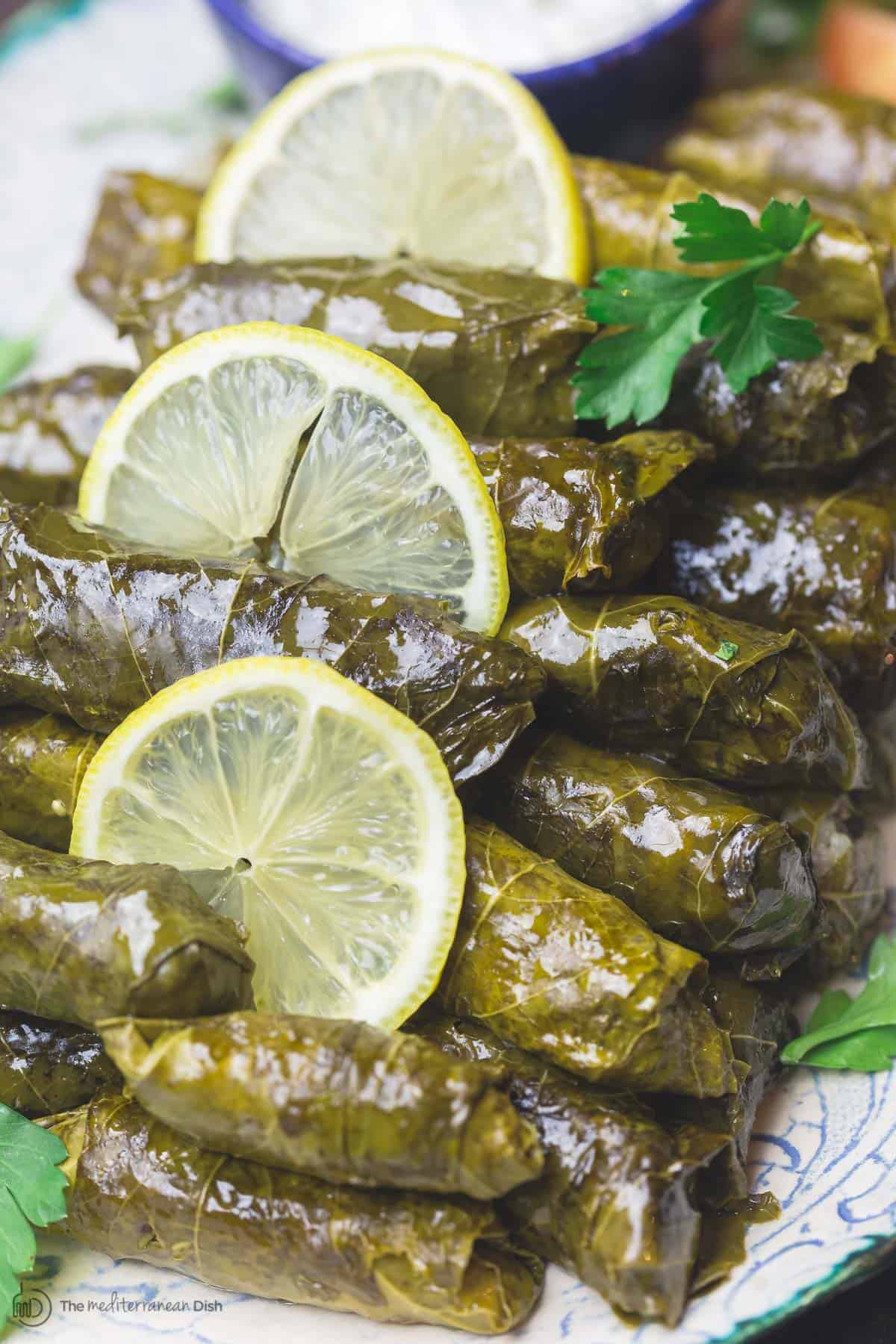
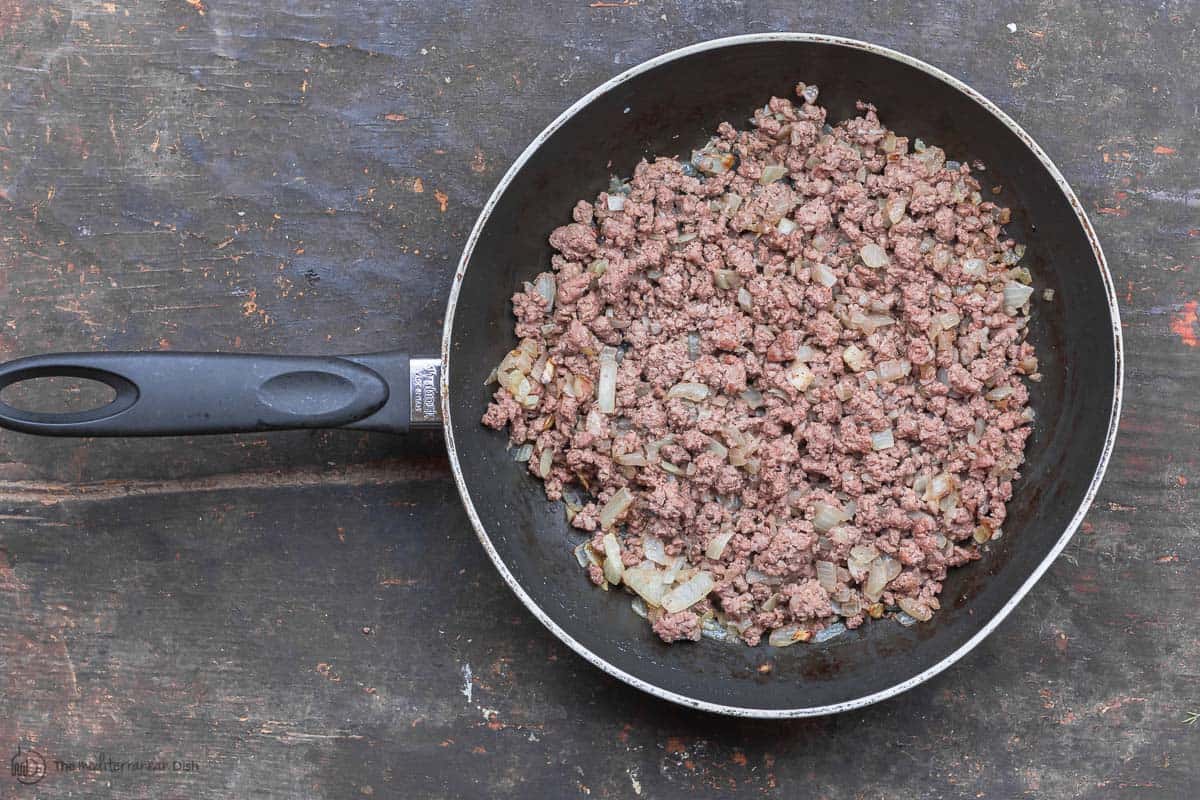
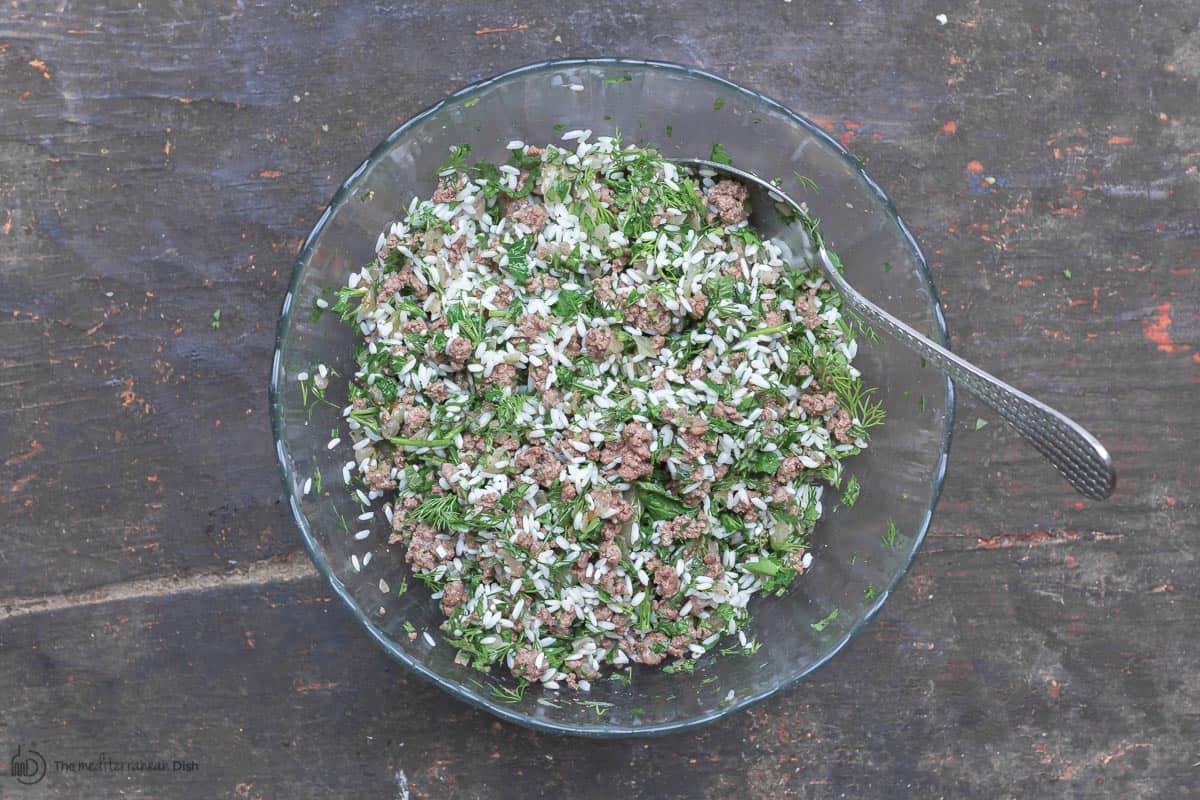
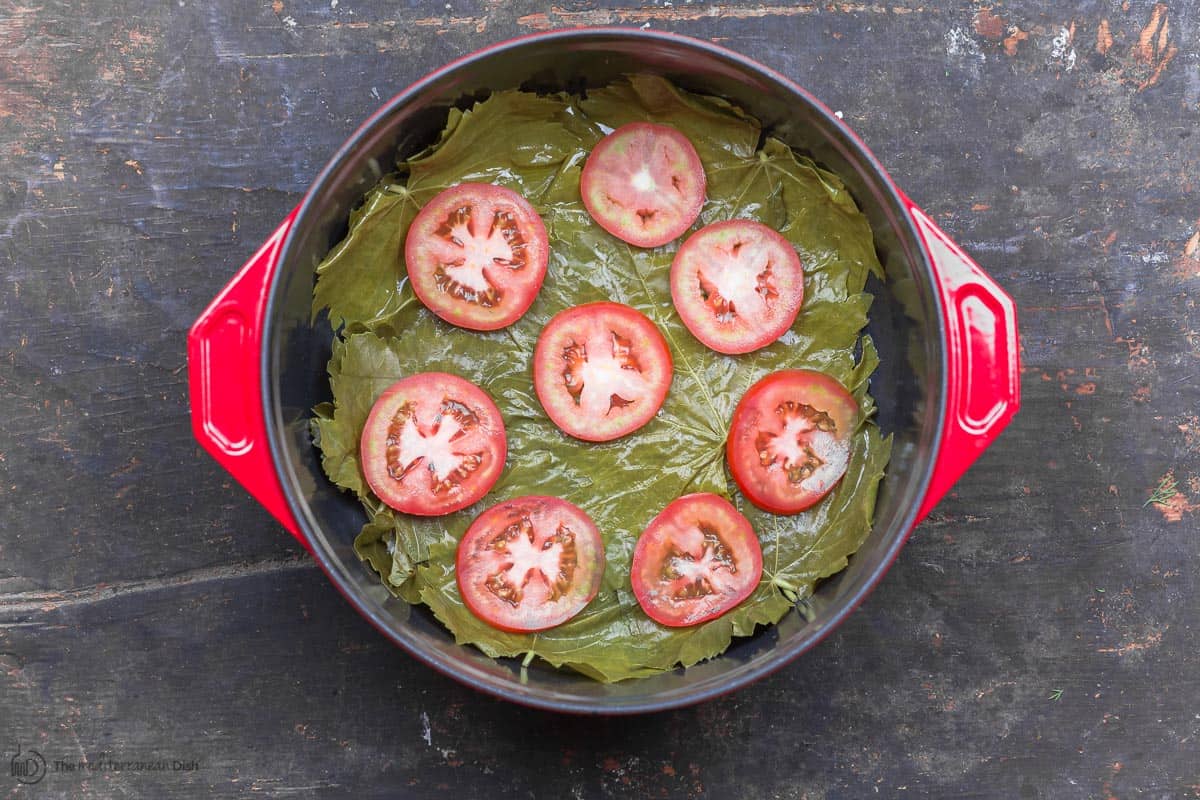
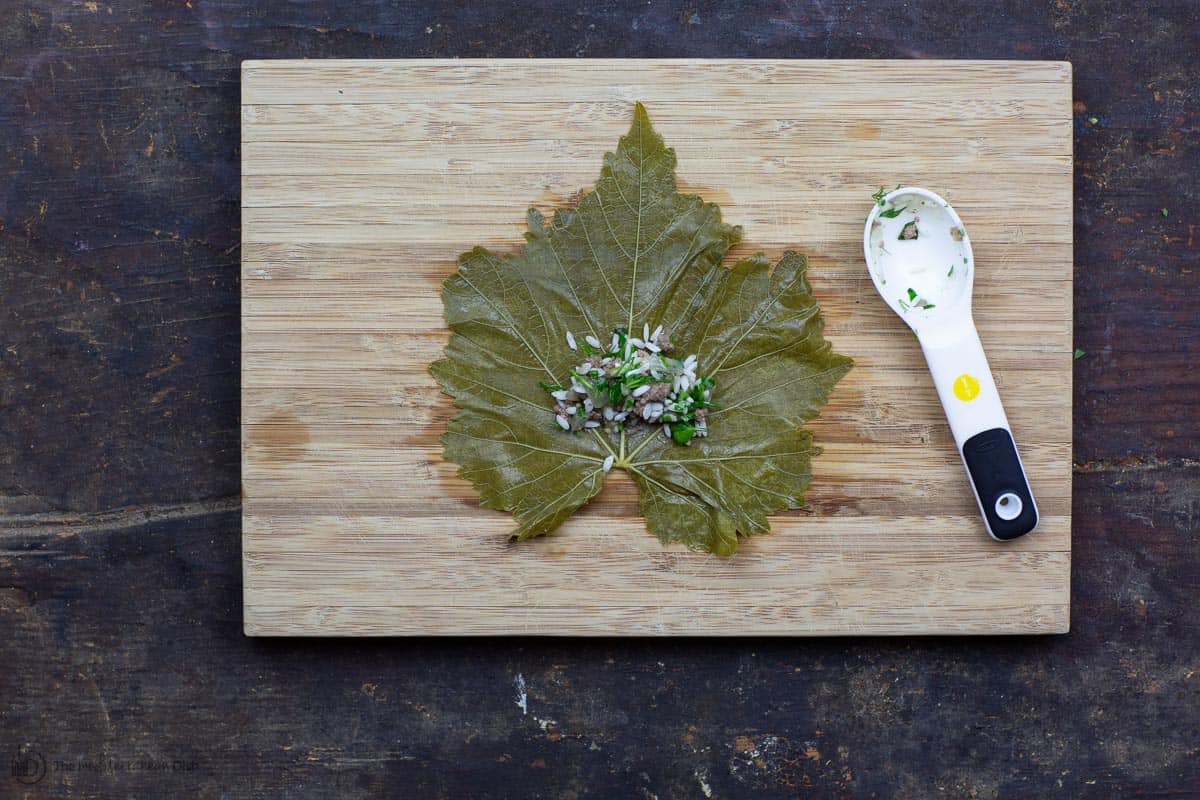
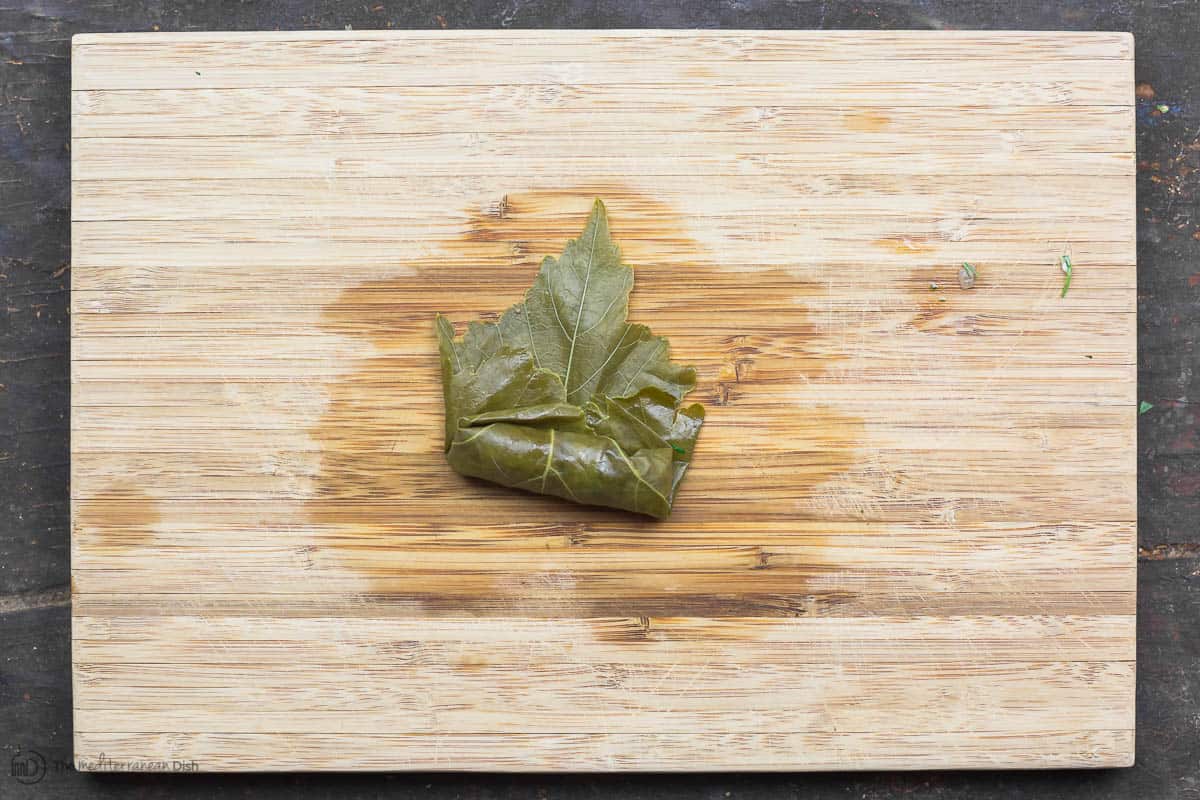
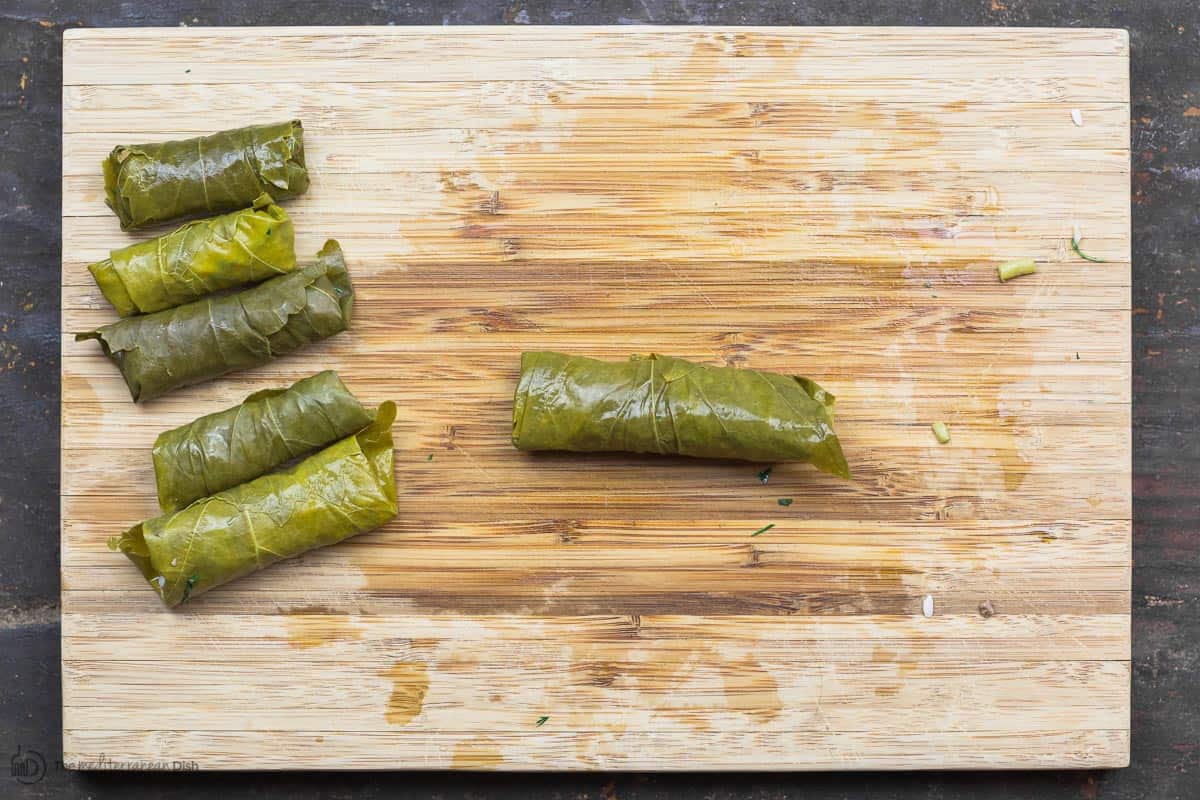
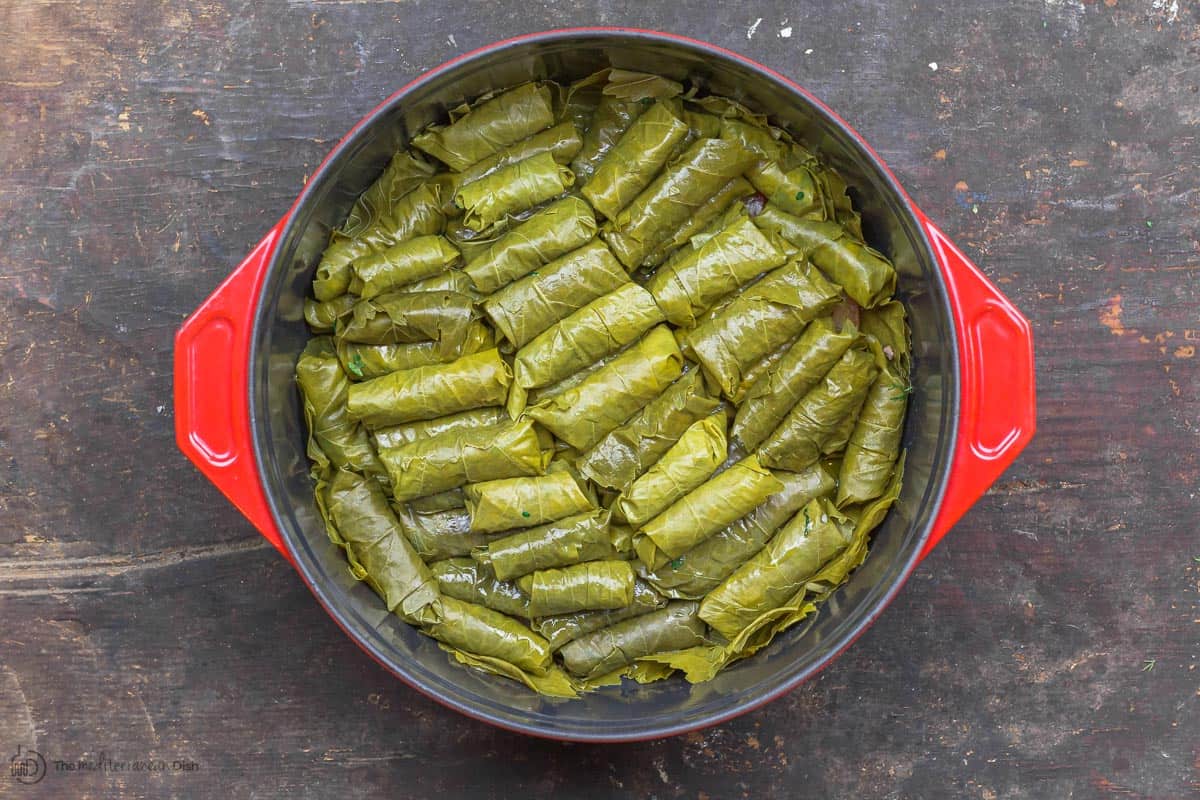
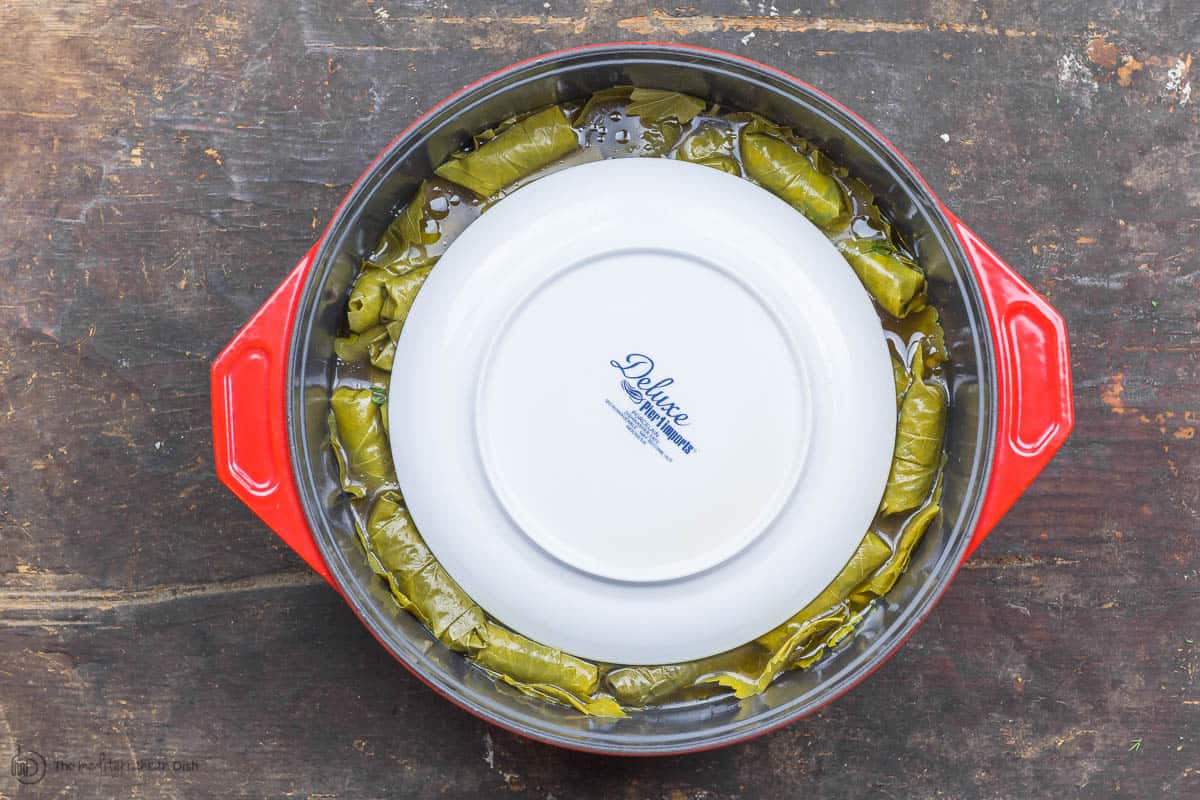
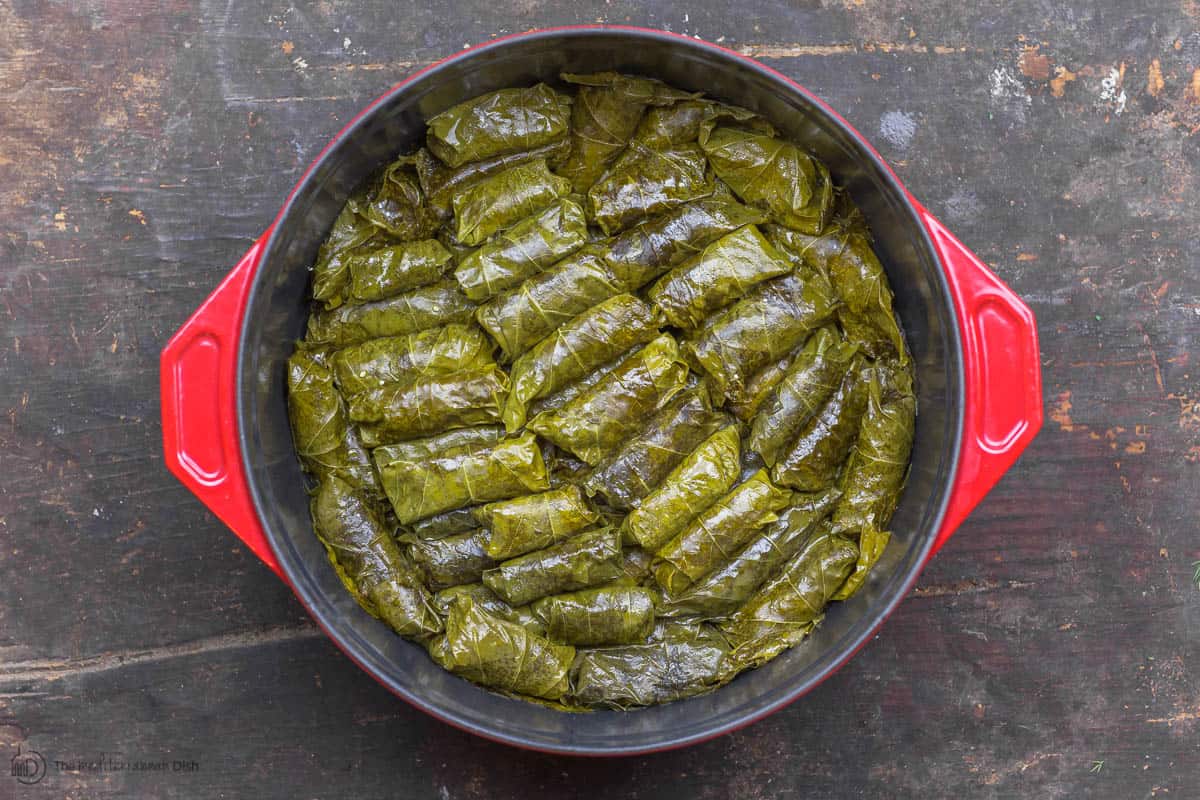
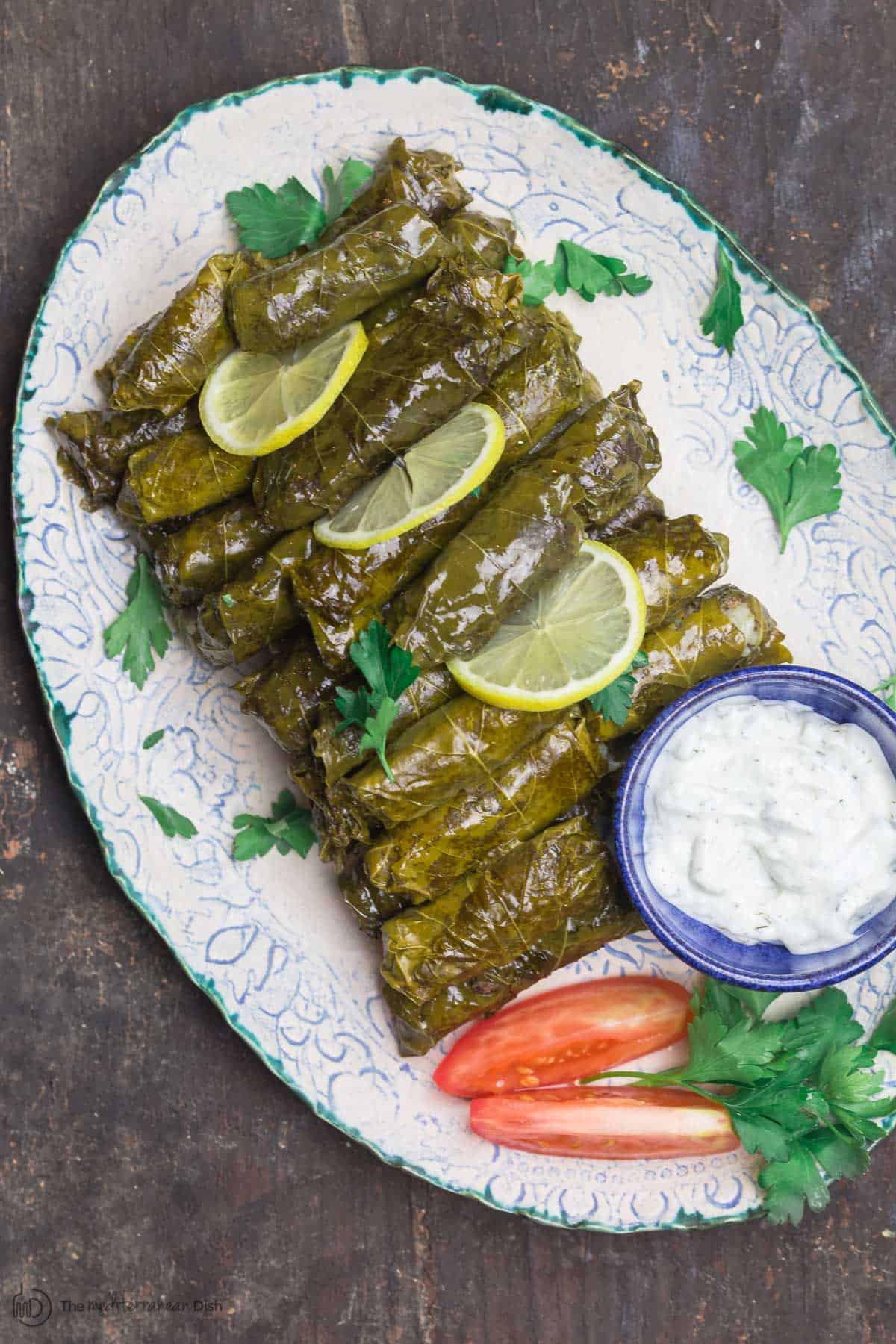
I can’t wait to make this recipe. I just ordered the leaves from your link. The link to watch this dish being prepared is missing. Perhaps that’s my issue.
Hi, Chris! I hope you enjoy the recipe! Yes, sometimes browsers block pop-ups, which affects our videos. You may be able to switch some settings in you current browser and get it to work … or maybe try switching to a different browser all together.
I followed the recipe as is except that I substituted quinoa for the rice and it turned out great. My only problem was that my grape leaves were a little tough. I think that was because I might have picked them from my vines a little too late. I picked them in the middle of July and froze them for the following year. I got the idea of freezing them instead of blanching them from a Jaques Peppin TV program where he recommended freezing cabbage leaves as an alternative to cooking them. As for the problem of lining the cooking vessel with leaves and tomatoes to prevent burning, I just put about a Tbsp of olive oil in the bottom of a heavy stainless steel brassier and placed one layer of leaves on the bottom. As it turned out, that wouldn’t even have been necessary. I think the thing is that you need a heavy bottomed cooking vessel. I just simmered every thing for about an hour until most of the liquid cooked away and nothing burned. I have seen other recipes where they mentioned dealing with a problem of sticking or burning. This year I think I’ll pick my leaves in June and see whether they will be more tender. Also, perhaps they do need to be blanched instead of freezing.
Thank you so much for sharing, Ken! How wonderful that you have home-grown grape leaves to be able to use!
I’ve also tried using fresh picked grape leaves and mine were tough as well. I did blanch mine. I do think the leaves need to be picked pretty young. But I’ve never attempted using fresh again. For me the jarred leaves worked out much better so I’ve just stuck with those.
Thanks for sharing your experience, Abby!
I really loved the Grape Leaves recipe. It was really simple yet very delicious and it had a room to add my own Afghani touch of spice into it. I took some pictures from them, but I couldn’t find the room to add them in the review site. Thanks again for the beautiful work.
Hi, Mahbooba! I’m so glad you enjoyed this recipe! I’m sorry that we don’t have the ability to share pictures here. You are welcome to share via Instagram or Facebook, though, if you are on either of those platforms.
I made these for vegan family friends and served with tzatziki made with coconut milk yogurt alternative. I used 1/2 cup extra rice and a 4 oz pack of pine nuts instead of the beef. It made tons and they devoured them. So delicious. At the end of the evening they asked if they could take some back to their hotel. It was hard to give them up, but, you know, friends. Highly recommend this recipe. Thank you so much for sharing your incredible cooking skills with us.
Thanks for sharing your adaptations, Susan! Very helpful!
Hi Susi, does the recipe work with dried herbs? Thanks!
Have you ever tried brown rice? Do you see it being an issue?
Hi, Lucie! I have not personally tried this recipe with brown rice, but I don’t think that would be an issue. You may need to adjust the cooking time and water amount a bit, though.
I used brown rice and it was fine
Great!! Thanks for sharing, Nancy!
These came out super delicious. I was afraid they were going to explode as I couldn’t figure out if I was rolling too tightly. I also added the lemon juice to the broth from the beginning to incorporate the lemon better. I read i don’t need to cook the meat in advance, do I just mix everything together and then roll them?
I’ll be making the Koshari next.
Hi, Renee… regarding using raw meat… you are correct. Just mix everything together and roll :). Hope you enjoy the Koshari!!
Can I substitute lamb for the ground beef? I’ve never made these before and want to make for Christmas.
Thanks for your reply
Absolutely! Enjoy!
I am Greek and am very excited to try your stuffed grape leaves recipe. Growing up, my parents used to make them together–my mom and dad filling and rolling the grape leaves on the kitchen table. They both have passed years ago and I’ve been searching for a recipe similar to theirs. This recipe looks very similar with the exception of the tomatoes. Also, they used to add Avgolemeno sauce at the end instead of 2 lemons which was also delicious! We used to spoon the grape leaves and sauce into a bowl to eat with crusty bread. I will definitely be making this very soon! Thanks for all your wonderful recipes and a trip down memory lane!
So glad to hear this fun memory! thanks for sharing
Can hardly wait to try them! Will post another comment after I try cooking them.
I can’t wait to hear what you think, Danny!!
I made these and they are very tasty. I got the Krinos brand of grape leaves soaked in brine from a local grocery store here. However my grape leaves are still chewy even after cooking them following your recipe. They did not have any stems and no thick veins but still chewy. How do I reduce their chewiness with the left over stuffed grape leaves? Can I bake these left over stuffed grape leaves or something to reduce their chewiness? I don’t want to waste them. Please advise! Thanks. Love your dishes btw! I have tried several of them already.
Depending on the barnd of grape leaves, it may help to boil the grape leaves brielfy in some water first to soften them some. I would not overdo this step, they need to be able to hold the filling well. I would say maybe 5 minutes or so (you’ll have to determine this depending on the leaves). Drain them well and allow them to cool before proceeding with the recipe.
The recipe may be good, but I warn you NEVER to buy the KRINOS brand of grape leaves. They are, without exaggeration, 1/3 to 1/2 the size of those shown in the photos here. The finished Dolmas are the size of the smallest joint of your little finger, and that applies to the smallest of hands. I nearly threw the whole batch of ingredients away.
Thank you for sharing that info, Tres!
Do not brown the meat first. Roll the leaves with raw ground, then stuff and cook
Hi, Tony. Yes, you can also make the mixture with the raw meat. The option to cook the meat first gives folks who are new to making stuffed grape leaves some peace of mind.
I have not tried making these yet, but I will. it will be my first time ever. I just have a question, can you freeze any of the left over stuffed leaves?
Sure! After they’re completely cooled, you can them in a freezer bag in one layer and freeze.
How do u reheat from frozen?
Hi, Debbie! To reheat, place in a pot with a tiny bit of liquid, cover and heat over medium-low heat until warmed through.
i am armenian and it was common for my folks to use canned tomato or fresh when available in the filling and juice from the tomato in the broth. in your judgement will this compromise your recipe and if not can you offer proportion. in addition i remember mixing the uncooked rice, seasoning, etc. in with raw meat, stuffing the leaves directly and pressure cooking until done – can you offer a comment?
Hi Ron, you can use fresh tomato juice here. And yes, you can also make the mixture with the raw meat (my mother makes it this way). The option to cook the meat first gives some folks who have not made stuffed grape leaves some peace of mind.
I’m a little confused about the tomatoes. Do you put the rolled up, stuffed leaves on top of tomatoes, which are at the bottom of the pan, do you stuff the leaves with tomato, or do you do something else with them? Very excited to try this recipe!
Hi Sarah, the sliced tomatoes are placed in the bottom of the pot as you see in the photos and the rolled grape leaves are arranged on top.